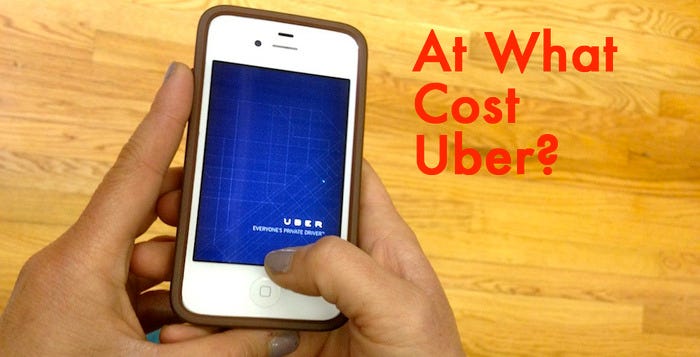By Noah Sanders

Started in 2009 by serial-entrepreneur Travis Kalanick, Uber, the little-car-service-that-could, has exploded in the last year, expanding to some 50 countries (including Kuala Lumpur and Hyderabad) and having a current value estimated at roughly $4 billion. On the heels of some bad press and in an ever-expanding effort to be the most viable car service company, Uber announced last week that it would slash the fees for its popular UberX line of vehicles, effectively undercutting other existing car service companies and most importantly, taxis.
Yes, lower prices for the same product seems pretty remarkable, but the price chopping comes with a little baggage. What exactly is Uber offering? What are the up and downsides of the changes? And is the cost-cutting everything it’s cracked up to be? Here’s what I found:
Where are we now?
Last week Uber announced that for a limited time they would experiment with slashing the costs of their UberX line (personal cars piloted by amateur drivers). The base rate for the service will drop down to $3, with each mile costing just $1.50. In comparison, taxis have a city-mandated (i.e. legally regulated) base rate of $3.50, with each mile costing an additional $2.75 for the rider. During the “experiment,” UberX drivers will see the 20% commission they owe to Uber on each fare, cut back to a marginal 5%, to ensure they still make money.
Cheaper rates! So why are some people in an uproar?
Two words: surge pricing. Uber is notorious for its Surge Pricing model. The idea is that at times when the need for an Uber is at its most premium (weekend nights, holidays, even inclement weather situations) the company can, and will, raise their prices based on an undisclosed algorithm. And these prices can be steep. New Yorkers recently saw prices multiplied by 7.75 times the normal cost on a recent particularly shitty weather evening. Uber argues that higher prices get more drivers on the road, and more drivers on the road helps to meet the demand quicker, thus lowering the prices back to normal.
So is it really cheaper? On a Wednesday at 1 p.m., when only a handful of souls are looking for a ride and a taxi is not in sight, UberX is going to seem like a nice option, but on a Friday night when everyone and their drunken sister is trying to haul their asses in to a shiny gray Prius, the car service will still cost whatever the company deems appropriate based on the demand. In a recent Wall Street Journal interview, Travis Kalanick said there’s an “education process” in learning how “dynamic pricing in transportation” works.
So what does it mean for us now and in the future?
There are people who love the new cab alternatives for being convenient, tech-savvy, and easy to use. Those are also the people who can afford to use them. Regular old taxis are still a luxury for most, but the rates are consistent and regulated. Even on the busiest night of the year, a taxi (if you can nab one) is going to cost the same, time-and-time again.
By dropping costs, Uber is no longer presenting themselves as a luxury service, but an option for the everyday citizen. At least during non-surge hours. These new rates will make it hard for taxi companies to compete, companies that are legally bound to follow a very strict set of rules, regulations, and permits that cost money (and help fund the city).
So the new UberX pricing might be cheap enough for more of us to use “everyone’s private driver” right now. But we should be asking ourselves a couple more questions: Will taxis’ dwindling incomes and customer base, coupled with Ubers cost-cutting efforts, put cabs entirely out of business? And if there’s no competition and no regulations to control prices, will hailing a car on a rainy Friday night become something only the wealthy can do?







